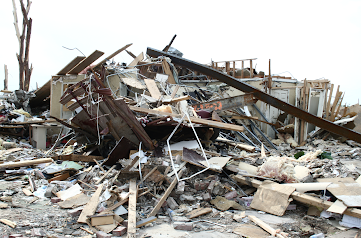12th Anniversary of the Joplin Tornado
An unfathomable tragedy occurred 12 years
ago today.
One of the worst tornadoes in United States' history occurred on this date in 2011. It was an EF-5 intensity storm and that ferocity, when combined with it striking a densely populated area, would inevitably lead to a huge number of deaths. But, it became the worst tornado of the tornado warning era because the tornado warnings and emergency management's siren activations were botched. Since the approaching tornado was behind a curtain of rain and could not be seen, the people of Joplin were sitting ducks. A total of 161 mothers, fathers, daughters and sons died, many unnecessarily.
 |
| National Weather Service |
Yet, the NWS, time after time, misstated the direction of the storm and where it would strike.
Then, incredibly, now that a tornado warning was in effect for the city, the tornado sirens were not sounded. The people of Joplin were going about their business, having been assured three minutes before by the media that everything was fine. The shoppers, people mowing their lawns, and leaving the high school graduation, had no way to know they were now in mortal danger.
The situation began with NWS in Springfield MO (which handles the Joplin area) issuing a tornado warning because of a supposed funnel cloud near Carl Junction. That warning never should be been issued as there was no rotation in the area. Worse, the tornado sirens were sounded in Joplin even though there was no threat to the city. The television and radio told the people of Joplin not to worry as the tornado threat, such that it was, was to the north.
Minutes later, an area of rotation developed and was increasing near Riverton, Kansas. As is the case with major tornado-producing supercells, the storm that Sunday moved straight east (to the "right" of the other storms which were moving northeast). Yet, the NWS in its tornado warning -- this time for Joplin -- said the tornado warning moving northeast. As the map below indicates, the northeast movement meant it would come nowhere near Joplin!
The NWS two more times said the tornado was moving to the northeast -- missing Joplin. The sirens were not reactivated until the tornado was in the far west part of the city doing damage and causing the first fatalities. I tell the entire story here.
The NWS's mess of the messaging even threw off the meteorologists providing storm coverage. Above is the storm coverage from KSNF-TV, the NBC station in Joplin. You hear the voice of meteorologist Caitlin McCardle nonchalantly describing the report of a funnel cloud (tornado aloft) near Galena, Kansas. Again, when they sent out the Galena funnel report, the NWS said the storm was still moving northeast -- which meant it would not hit Joplin.
The KSNF's master controllman on his own initiative put the live cloud camera on the air. There were flashes which newsman Jeremiah Cook interpreted as lightning. Being a meteorologist, Caitlin knew better. Her entire tone of voice changed when she suddenly realized the camera was showing the tornado. She and Jeremiah begin shouting, "Take cover!" The NWS had led her to believe Joplin was okay. When I interviewed her for my book (red link above), she said, "I was shocked there was a tornado in that location [southwest Joplin]!"
The TV station's camera was able to briefly see the tornado because it was looking from north to south. But, along the storm's path, it was completely invisible. Below is video and audio taken by a van with "Silver Lining Tours," a storm tourism company. You hear the sirens come on ten seconds into the video. But, as the storm tourists in the van turn their camera to the west (they were in the path, the stores seen would be destroyed minutes later), nothing. No sign of a tornado.
The sirens were turned on because a storm chaser, Jeff Piotrowski, pulled alongside a police car and pleaded with them to, "Get the sirens on now!!"
Given the tornado was invisible, the people of Joplin were 100% dependent on the National Weather Service and local emergency management-- which utterly failed them, even though this was a textbook situation.
To demonstrate this was a highly "warnable" tornado, below is the warning my company send to our two railroad clients in the path of the storm.
Kansas City Southern did not have a train in the area. But, American Rail Dispatch did -- and, per their letter two days later -- they moved people and equipment safely out of the tornado's path. We didn't know it in 2011, but the "golden age" of tornado warnings had ended with Joplin. From 2001 to 2011, per their own statistics, NWS tornado warning accuracy peaked. Since then, too many strong tornadoes have failed to be adequately warned. The Weather Service seems to be in denial.
Given that denial, I believe the only way to fix tornado warnings, other issues in the NWS's storm warning program, issues with FEMA, et cetera, is for Congress to create a National Disaster Review Board modeled after the hugely successful National Transpiration Safety Board. Otherwise, another Joplin is inevitable.







Comments
Post a Comment